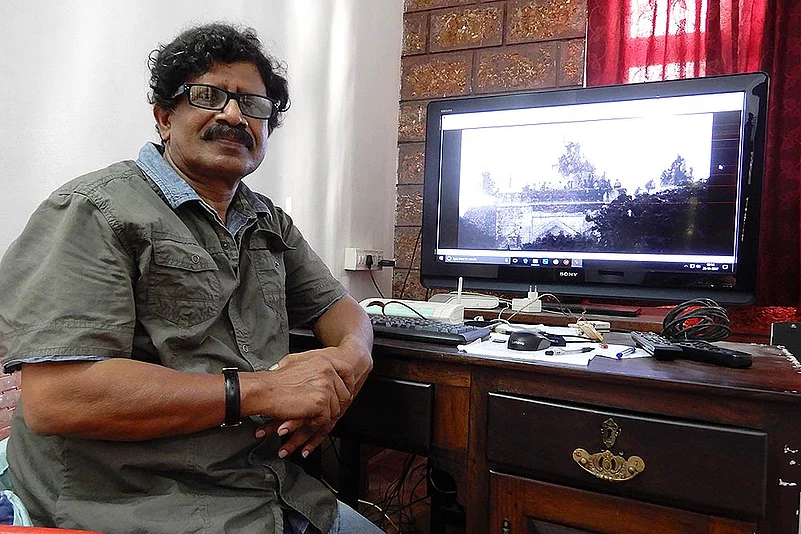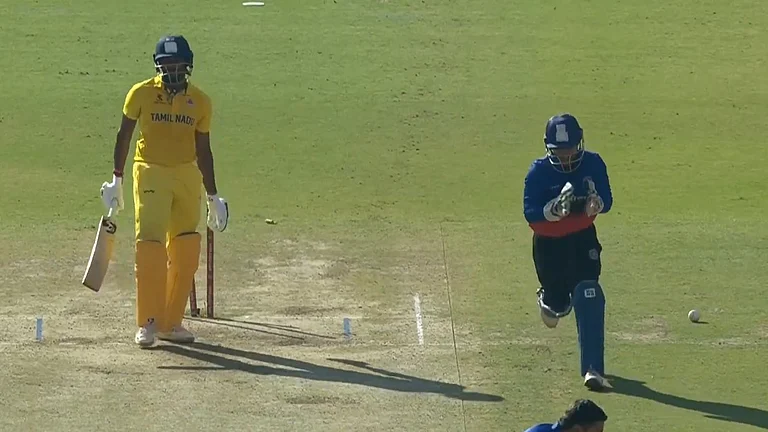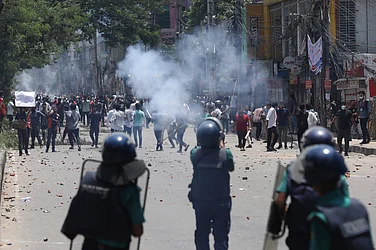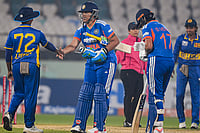It was a feverish night. In a small hotel room in Faizabad, I tossed and turned on my bed all night. Sleep had deserted me. My mind was crowded with thoughts of the previous day, December 6, 1992, which had left me heartbroken. I felt deep within me that the demolition of the medieval-era mosque had struck at independent India’s soul, and changed it irrevocably. The demolition of any place of worship, whether it’s a temple, a church or a mosque, would have had the same devastating effect on me. And I had witnessed a mosque being razed to the ground in a hate-filled atmosphere. We had also seen the beginnings of the aftermath: burning tyres strewn around, the rising smoke and the militant kar sevaks ready to beat up photographers.
As I lay there on my bed, I heard the azaan, the call to prayer, breaking the day. It was a startling note in that darkness, that of one brave Muslim calling out to the faithful.
This was not my first visit to Ayodhya. I had gone there twice before to photograph the kar seva (voluntary service for temple construction) in 1990 and 1991. In October 1990, BJP leader L.K. Advani’s rath yatra was stopped in Bihar and Advani was arrested, but the kar sevaks journeyed on to Ayodhya. A few of them broke through the heavily guarded cordon and one managed to climb the disputed Babri Masjid and place a saffron flag atop the masjid.
I was working as a photographer for Malayala Manorama and The Week at that time and, in 42 years as a photographer, I have never been injured except that once. A few kar sevaks were throwing bricks at the Provincial Armed Constabulary (PAC) stationed there and one brick hit me on my back and the horrible pain festered for many months. A few died in the police firing that ensued.
In 1991, Ayodhya was calm as the kar sevaks did not attempt anything. Journalist N. Vijay Mohan and I went through the bylanes of Ayodhya exploring. We found to our pleasant surprise that Hindus lived in harmony with Muslims in the city. Though I can’t recall their names, we found that the poor from both religions had teamed up to grow flowers that were sold for puja in the temples, or to sell cassettes of devotional songs. The Muslims did the block printing of Ram on the yellow cloth that the kar sevaks donned. We found Muslim carpenters busy making paduka (wooden footwear) for the devotees of Rama.
I visited the Babri Masjid too and everyone, including the sadhus, were frisked at the entrance. No leather, not even the leather watch strap, was allowed into the premises, nor allowed into any of the numerous temples that dot Ayodhya. But, the people wearing the paduka could walk right into a temple without removing their footwear.
But December 1992 was something else and Ayodhya was not the same. Almost expecting this, a large platoon of journalists and photographers, including foreign ones, had descended on Faizabad. The news reports, I read later, said there were at least 200 photographers and reporters in Ayodhya at that time. This created another problem for us, as the best hotels in Faziabad, around 10 km from the masjid, were full by the time I landed there with The Week reporter R. Prasannan on December 3. We managed to get a room in a small hotel, with basic facilities.
The hotel owner was providing help to kar sevaks, who were arriving in hordes from different parts of the country. This must have alarmed Prasannan, and he decided it was better that I didn’t reveal my identity and promptly christened me Muthu. That’s when I first felt a tremor of uneasiness within me. Even then, no one was sure what would unfold in Ayodhya, so I gave my actual name to the Vishwa Hindu Parishad (VHP) office for the issuance of passes to the masjid site. My pass clearly revealed my Muslim identity, but I didn’t think too much about it.
December 5 was an evening of demonstrations. The kar sevaks from different states and regions exhibited their skills in handling tridents and marching in unison. When Vinay Katiyar, founder-president of the VHP’s youth wing Bajrang Dal, led his group in a march towards the masjid, the Indian Express photographer and I began clicking pictures. He stepped into their path to get better pictures and he was roughed up by Bajrang Dal activists. They also pulled out his film, even though he had only taken a harmless photograph of a demonstration. The antagonism had been bared. Meanwhile, I scouted for a vantage point to position ourselves the next day. I identified the terrace of a two-storeyed building about 200-300 feet directly opposite the masjid. There were many others who thought like me.
On the morning of December 6, we arrived early at the masjid and I went inside with those who were seeing it for the first time. It was a hurried affair for the few people who were being allowed inside. None of us knew it would be rubble in a few hours. Soon after we took our places atop the terrace, Advani, then BJP president Murli Manohar Joshi, Maharashtra BJP leader Pramod Mahajan and VHP president Ashok Singhal arrived and went right into the masjid. It was probably the sadhus, entering in their wake, who whisked away the Ram Lalla statues and other artefacts from within the masjid. Soon the place was crawling with kar sevaks, who chased the CRPF and PAC jawans. They had to withdraw because they were heavily outnumbered by the over 1.5 lakh kar sevaks who had reportedly gathered in Ayodhya.
We could watch the kar sevaks’ body language change. Many of the photographers on the ground, who were being questioned initially, were later beaten up and their cameras destroyed. According to reports, 30-50 photographers were injured. The kar sevaks rushed atop the domes of the masjid. The loud cries and rising dust as the hammers came crashing on the building from all sides reverberated across the grounds. I could hardly take the pictures, for I was trembling with fear and anguish. The hatred for Muslims and photographers was palpable and I was both. I was perhaps the only Muslim among the press there that day. I shoved the film rolls and my identity card into my socks. Then we saw a group running towards our building,. That’s when I left behind my big bag with two expensive cameras in it, and made good my escape with the others. Our vehicle was stopped many times, but we were let off. That night, I developed the film surreptitiously in a studio and used the transmitter I carried around to send the first pictures of the demolition to Malayala Manorama in Kottayam.
It was perhaps the biggest news story in my life, but Malayala Manorama chose not to publish a single picture of the demolition for a noble reason—to avoid riots in Kerala. To this day, they have not done so. To think about it, I don’t really mind it.
As told to Minu Ittyipe
(The writer is a Kozhikode-based photojournalist who witnessed the demolition of the Babri Masjid.)





















